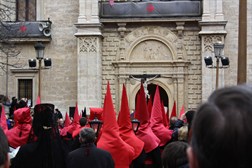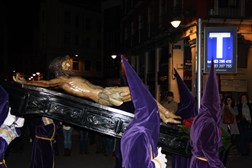The Holy Week of Valladolid
 Holy Week in Valladolid has its roots in the fifteenth century, when the first processions began to take place. The founding of the two oldest confraternities (cofradías) which still parade through the streets of the city in the days leading up to Easter go back to the final years of the century: the Cofradía de la Venerable Orden Tercera de San Francisco (Venerable Confraternity of the Third Order of Saint Francis) and the Cofradia Penitencial de la Santa Vera-Cruz (Penitential Confraternity of the Holy True Cross), born in 1498. The next century saw the birth of the Cofradía Penitencial de la Sagrada Pasión de Cristo (Penitential Confraternity of the Sacred Passion of Christ, 1531), the Ilustre Cofradía Penitencial de Nuestra Señora de las Angustias (The Illustrious Penitential Confraternity of Our Lady of Sorrows, 1536), the Muy Ilustre Cofradía de Nuestra Señora de la Piedad (The Most Illustrious Confraternity of Our Lady of Piety, 1578) and the Cofradía Penitencial de Nuestro Padre Jesús Nazareno (The Penitential Confraternity of Our Father Jesus the Nazarene, 1596).
Holy Week in Valladolid has its roots in the fifteenth century, when the first processions began to take place. The founding of the two oldest confraternities (cofradías) which still parade through the streets of the city in the days leading up to Easter go back to the final years of the century: the Cofradía de la Venerable Orden Tercera de San Francisco (Venerable Confraternity of the Third Order of Saint Francis) and the Cofradia Penitencial de la Santa Vera-Cruz (Penitential Confraternity of the Holy True Cross), born in 1498. The next century saw the birth of the Cofradía Penitencial de la Sagrada Pasión de Cristo (Penitential Confraternity of the Sacred Passion of Christ, 1531), the Ilustre Cofradía Penitencial de Nuestra Señora de las Angustias (The Illustrious Penitential Confraternity of Our Lady of Sorrows, 1536), the Muy Ilustre Cofradía de Nuestra Señora de la Piedad (The Most Illustrious Confraternity of Our Lady of Piety, 1578) and the Cofradía Penitencial de Nuestro Padre Jesús Nazareno (The Penitential Confraternity of Our Father Jesus the Nazarene, 1596).
Between 1601 and 1606, Valladolid was the seat of the court of the King of Spain, and as such became the centre of many political and religious feasts, ceremonies and rituals. As the Portuguese chronicler Tomé Pinheiro da Veiga in his work Fastiginia recounted, on Good Friday of 1605, the day of the birth of the heir, the future Philip IV, five processions took to the streets of the city, each carrying various pasos, of exquisite artistry. The seventeenth century was the golden era of Baroque sculpture from Valladolid, in which many of the most beautiful and famous pasos were created which still march in processions.
 Holy Week in Valladolid experienced a long period of crisis in the nineteenth century. In 1810, French General Kellerman imposed the implementation of a provision that had been enacted four years previously which demanded the unification of all the processions in a single Procesión de la Sagrada Pasión del Redentor (Procession of the Sacred Passion of the Redeemer), in order to reduce the costs and problems of public order generated by the proliferation of ceremonies. Although this situation only lasted for a few years, until the end of the Napoleonic domination, in the course of the century the Holy Week struggled to regain its former glory. Indeed, it was only in the twentieth century that it came to represent a key event in the life and identity of the city itself, as evinced by the fact that many new cofradías were founded during the twentieth century. In 1920 the Procesión General del Viernes Santo (General Procession of Holy Friday), which still brings together all the confraternities and the majority of the pasos.
Holy Week in Valladolid experienced a long period of crisis in the nineteenth century. In 1810, French General Kellerman imposed the implementation of a provision that had been enacted four years previously which demanded the unification of all the processions in a single Procesión de la Sagrada Pasión del Redentor (Procession of the Sacred Passion of the Redeemer), in order to reduce the costs and problems of public order generated by the proliferation of ceremonies. Although this situation only lasted for a few years, until the end of the Napoleonic domination, in the course of the century the Holy Week struggled to regain its former glory. Indeed, it was only in the twentieth century that it came to represent a key event in the life and identity of the city itself, as evinced by the fact that many new cofradías were founded during the twentieth century. In 1920 the Procesión General del Viernes Santo (General Procession of Holy Friday), which still brings together all the confraternities and the majority of the pasos.
 Currently, the celebrations of Holy Week in Valladolid begin with Viernes de Dolores (Friday of Sorrows), and continue in the following days until the day of Easter. Friday is characterized not only by the Procesión General, but also by the Sermón de las Siete Palabras (Sermon of the Seven Words) which is pronounced by a preacher at noon, in the Plaza Mayor decked out for the occasion with large black tarps. By contrast, during Holy Saturday one of the versions of the Dead Christ by Gregorio Fernández, the greatest Spanish sculptor of the Baroque period, is carried in procession. Other pasos and images by Fernández and other great Baroque artists do not march any more today during Holy Week, in order to preserve their great artistic value which is the case, for example, with Gregorio Fernández’s Piedad (1619), preserved in the Museo Nacional de Escultura. The Holy Week celebrations culminate on Easter Sunday, with the solemn Mass celebrated by the Archbishop of Valladolid in the cathedral.
Currently, the celebrations of Holy Week in Valladolid begin with Viernes de Dolores (Friday of Sorrows), and continue in the following days until the day of Easter. Friday is characterized not only by the Procesión General, but also by the Sermón de las Siete Palabras (Sermon of the Seven Words) which is pronounced by a preacher at noon, in the Plaza Mayor decked out for the occasion with large black tarps. By contrast, during Holy Saturday one of the versions of the Dead Christ by Gregorio Fernández, the greatest Spanish sculptor of the Baroque period, is carried in procession. Other pasos and images by Fernández and other great Baroque artists do not march any more today during Holy Week, in order to preserve their great artistic value which is the case, for example, with Gregorio Fernández’s Piedad (1619), preserved in the Museo Nacional de Escultura. The Holy Week celebrations culminate on Easter Sunday, with the solemn Mass celebrated by the Archbishop of Valladolid in the cathedral.
